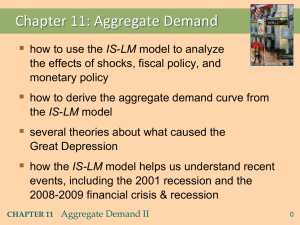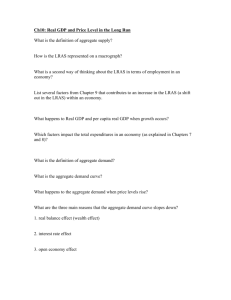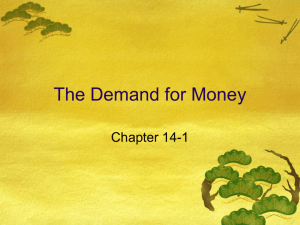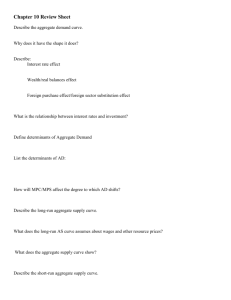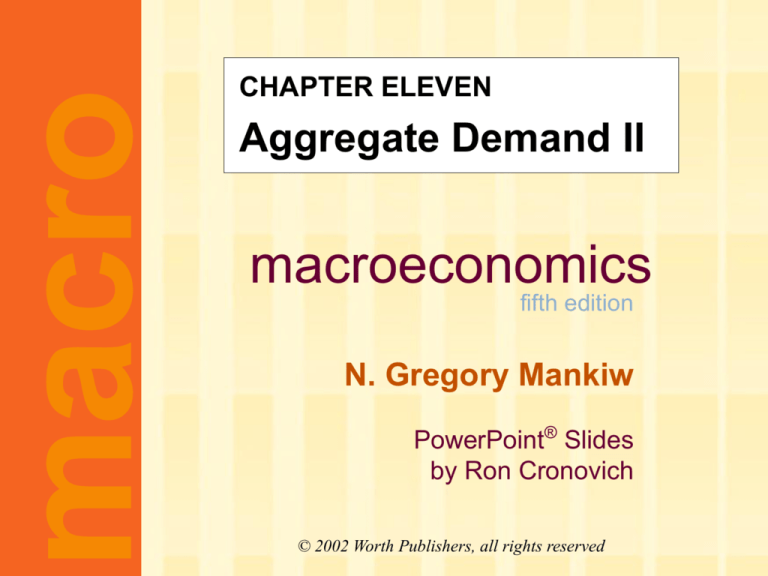
macro
CHAPTER ELEVEN
Aggregate Demand II
macroeconomics
fifth edition
N. Gregory Mankiw
PowerPoint® Slides
by Ron Cronovich
© 2002 Worth Publishers, all rights reserved
Context
Chapter 9 introduced the model of aggregate
demand and supply.
Chapter 10 developed the IS-LM model, the
basis of the aggregate demand curve.
In Chapter 11, we will use the IS-LM model to
– see how policies and shocks affect income
and the interest rate in the short run when
prices are fixed
– derive the aggregate demand curve
– explore various explanations for the
Great Depression
CHAPTER 11
Aggregate Demand II
slide 1
Equilibrium in the IS-LM Model
The IS curve represents
equilibrium in the goods
market.
Y C (Y T ) I (r ) G
r
LM
The LM curve represents r1
money market equilibrium.
IS
M P L (r ,Y )
Y1
The intersection determines
the unique combination of Y and r
that satisfies equilibrium in both markets.
CHAPTER 11
Aggregate Demand II
Y
slide 2
Policy analysis with the IS-LM Model
Y C (Y T ) I (r ) G
r
LM
M P L (r ,Y )
Policymakers can affect
macroeconomic variables
r1
with
• fiscal policy: G and/or T
• monetary policy: M
We can use the IS-LM
model to analyze the
effects of these policies.
CHAPTER 11
Aggregate Demand II
IS
Y1
Y
slide 3
An increase in government purchases
r
1. IS curve shifts right
1
by
G
1 MPC
causing output &
income to rise.
2. This raises money
2.
LM
r2
r1
3. …which reduces investment,
so the final increase in Y
1
is smaller than
G
1 MPC
CHAPTER 11
Aggregate Demand II
IS2
1.
demand, causing the
interest rate to rise…
IS1
Y1 Y2
Y
3.
slide 4
A tax cut
Because consumers save
(1MPC) of the tax cut,
the initial boost in
spending is smaller for T
than for an equal G…
and the IS curve
shifts by
MPC
1.
T
1 MPC
r
r2
2.
r1
2. …so the effects on r and Y
are smaller for a T than
for an equal G.
CHAPTER 11
LM
Aggregate Demand II
1.
IS2
IS1
Y1 Y2
Y
2.
slide 5
Monetary Policy: an increase in M
1. M > 0 shifts
the LM curve down
(or to the right)
2. …causing the
interest rate to fall
r
LM2
r1
r2
3. …which increases
investment, causing
output & income to
rise.
CHAPTER 11
LM1
Aggregate Demand II
IS
Y1 Y2
Y
slide 6
Interaction between
monetary & fiscal policy
Model:
monetary & fiscal policy variables
(M, G and T ) are exogenous
Real world:
Monetary policymakers may adjust M
in response to changes in fiscal policy,
or vice versa.
Such interaction may alter the impact of
the original policy change.
CHAPTER 11
Aggregate Demand II
slide 7
The Fed’s response to G > 0
Suppose Congress increases G.
Possible Fed responses:
1. hold M constant
2. hold r constant
3. hold Y constant
In each case, the effects of the G
are different:
CHAPTER 11
Aggregate Demand II
slide 8
Response 1: hold M constant
If Congress raises G,
the IS curve shifts
right
If Fed holds M
constant, then LM
curve doesn’t shift.
r
LM1
r2
r1
IS2
IS1
Results:
Y Y 2 Y1
Y1 Y2
Y
r r2 r1
CHAPTER 11
Aggregate Demand II
slide 9
Response 2: hold r constant
If Congress raises G,
the IS curve shifts
right
r
To keep r constant,
Fed increases M to
shift LM curve right.
r2
r1
LM1
IS2
IS1
Results:
Y Y 3 Y1
LM2
Y1 Y2 Y3
Y
r 0
CHAPTER 11
Aggregate Demand II
slide 10
Response 3: hold Y constant
If Congress raises G,
the IS curve shifts
right
To keep Y constant,
Fed reduces M to
shift LM curve left.
LM2
LM1
r
r3
r2
r1
IS2
IS1
Results:
Y 0
Y1 Y2
Y
r r3 r1
CHAPTER 11
Aggregate Demand II
slide 11
Estimates of fiscal policy multipliers
from the DRI macroeconometric model
Estimated
value of
Y / G
Estimated
value of
Y / T
Fed holds money
supply constant
0.60
0.26
Fed holds nominal
interest rate constant
1.93
1.19
Assumption about
monetary policy
CHAPTER 11
Aggregate Demand II
slide 12
Shocks in the IS-LM Model
IS shocks: exogenous changes in the
demand for goods & services.
Examples:
• stock market boom or crash
change in households’ wealth
C
• change in business or consumer
confidence or expectations
I and/or C
CHAPTER 11
Aggregate Demand II
slide 13
Shocks in the IS-LM Model
LM shocks: exogenous changes in the
demand for money.
Examples:
• a wave of credit card fraud increases
demand for money
• more ATMs or the Internet reduce money
demand
CHAPTER 11
Aggregate Demand II
slide 14
EXERCISE:
Analyze shocks with the IS-LM model
Use the IS-LM model to analyze the effects of
1. A boom in the stock market makes
consumers wealthier.
2. After a wave of credit card fraud, consumers
use cash more frequently in transactions.
For each shock,
a. use the IS-LM diagram to show the effects
of the shock on Y and r .
b. determine what happens to C, I, and the
unemployment rate.
CHAPTER 11
Aggregate Demand II
slide 15
CASE STUDY
The U.S. economic slowdown of 2001
~What happened~
1. Real GDP growth rate
1994-2000: 3.9% (average annual)
2001: 1.2%
2. Unemployment rate
Dec 2000: 4.0%
Dec 2001: 5.8%
CHAPTER 11
Aggregate Demand II
slide 16
CASE STUDY
The U.S. economic slowdown of 2001
~Shocks that contributed to the slowdown~
1. Falling stock prices
From Aug 2000 to Aug 2001: -25%
Week after 9/11: -12%
2. The terrorist attacks on 9/11
• increased uncertainty
• fall in consumer & business confidence
Both shocks reduced spending and
shifted the IS curve left.
CHAPTER 11
Aggregate Demand II
slide 17
CASE STUDY
The U.S. economic slowdown of 2001
~The policy response~
1. Fiscal policy
• large long-term tax cut,
immediate $300 rebate checks
• spending increases:
aid to New York City & the airline industry,
war on terrorism
2. Monetary policy
• Fed lowered its Fed Funds rate target
11 times during 2001, from 6.5% to 1.75%
• Money growth increased, interest rates fell
CHAPTER 11
Aggregate Demand II
slide 18
CASE STUDY
The U.S. economic slowdown of 2001
~What’s happening now~
In the first quarter of 2002, Real GDP grew at
an annual rate of 6.1%, according to final
figures released by the Bureau of Economic
Analysis on June 27, 2002.
However, in its news release of June 7, 2002,
the NBER Business Cycle Dating Committee
had not yet determined the date of the trough
in economic activity, though it acknowledges
that the economy seems to be picking up.
CHAPTER 11
Aggregate Demand II
slide 19
What is the Fed’s policy instrument?
What the newspaper says:
“the Fed lowered interest rates by one-half point today”
What actually happened:
The Fed conducted expansionary monetary policy to
shift the LM curve to the right until the interest rate fell
0.5 points.
The Fed targets the Federal Funds rate:
it announces a target value,
and uses monetary policy to shift the LM curve
as needed to attain its target rate.
CHAPTER 11
Aggregate Demand II
slide 20
What is the Fed’s policy instrument?
Why does the Fed target interest rates
instead of the money supply?
1) They are easier to measure than the
money supply
2) The Fed might believe that LM shocks are
more prevalent than IS shocks. If so, then
targeting the interest rate stabilizes income
better than targeting the money supply.
(See Problem 7 on p.306)
CHAPTER 11
Aggregate Demand II
slide 21
IS-LM and Aggregate Demand
So far, we’ve been using the IS-LM model
to analyze the short run, when the price
level is assumed fixed.
However, a change in P would shift the LM
curve and therefore affect Y.
The aggregate demand curve
(introduced in chap. 9 ) captures this
relationship between P and Y
CHAPTER 11
Aggregate Demand II
slide 22
Deriving the AD curve
Intuition for slope
of AD curve:
P (M/P )
LM shifts left
r
I
Y
r
LM(P2)
LM(P1)
r2
r1
IS
P
Y2
Y
P2
P1
AD
Y2
CHAPTER 11
Y1
Aggregate Demand II
Y1
Y
slide 23
Monetary policy and the AD curve
The Fed can increase
aggregate demand:
M LM shifts right
r
LM(M1/P1)
LM(M2/P1)
r1
r2
IS
r
I
P
Y at each
value of P
P1
Y1
Y1
CHAPTER 11
Aggregate Demand II
Y2
Y2
Y
AD2
AD1
Y
slide 24
Fiscal policy and the AD curve
Expansionary fiscal policy
(G and/or T )
increases agg. demand:
r
LM
r2
r1
IS2
T C
IS1
IS shifts right
P
Y1
Y2
Y
Y at each
value
P1
of P
Y1
CHAPTER 11
Aggregate Demand II
Y2
AD2
AD1
Y
slide 25
IS-LM and AD-AS
in the short run & long run
Recall from Chapter 9:
The force that moves
the economy from the short run to the long run
is the gradual adjustment of prices.
In the short-run
equilibrium, if
then over time,
the price level will
Y Y
rise
Y Y
fall
Y Y
remain constant
CHAPTER 11
Aggregate Demand II
slide 26
The SR and LR effects of an IS shock
r
A negative IS shock
shifts IS and AD left,
causing Y to fall.
LRAS LM(P )
1
IS2
Y
P
SRAS1
Y
Aggregate Demand II
Y
LRAS
P1
CHAPTER 11
IS1
AD1
AD2
Y
slide 27
The SR and LR effects of an IS shock
r
LRAS LM(P )
1
In the new short-run
equilibrium, Y Y
IS2
Y
P
SRAS1
Y
Aggregate Demand II
Y
LRAS
P1
CHAPTER 11
IS1
AD1
AD2
Y
slide 28
The SR and LR effects of an IS shock
r
LRAS LM(P )
1
In the new short-run
equilibrium, Y Y
IS2
Over time,
P gradually falls,
which causes
• SRAS to move down
• M/P to increase,
which causes LM
to move down
CHAPTER 11
Y
P
Y
LRAS
P1
Aggregate Demand II
IS1
SRAS1
Y
AD1
AD2
Y
slide 29
The SR and LR effects of an IS shock
r
LRAS LM(P )
1
LM(P2)
IS2
Over time,
P gradually falls,
which causes
• SRAS to move down
• M/P to increase,
which causes LM
to move down
CHAPTER 11
Y
P
IS1
Y
LRAS
P1
SRAS1
P2
SRAS2
Aggregate Demand II
Y
AD1
AD2
Y
slide 30
The SR and LR effects of an IS shock
r
LRAS LM(P )
1
LM(P2)
This process continues
until economy reaches
a long-run equilibrium
with
Y Y
IS2
Y
P
Y
LRAS
P1
SRAS1
P2
SRAS2
Y
CHAPTER 11
IS1
Aggregate Demand II
AD1
AD2
Y
slide 31
EXERCISE:
Analyze SR & LR effects of M
a. Draw the IS-LM and AD-AS r
diagrams as shown here.
LRAS LM(M /P )
1
1
b. Suppose Fed increases M.
Show the short-run effects
on your graphs.
c. Show what happens in the
transition from the short
P
run to the long run.
d. How do the new long-run
P1
equilibrium values of the
endogenous variables
compare to their initial
values?
CHAPTER 11
Aggregate Demand II
IS
Y
Y
LRAS
SRAS1
AD1
Y
Y
slide 32
The Great Depression
220
billions of 1958 dollars
30
Unemployment
(right scale)
25
200
20
180
15
160
10
Real GNP
(left scale)
140
120
1929
percent of labor force
240
5
0
1931
CHAPTER 11
1933
1935
Aggregate Demand II
1937
1939
slide 33
The Spending Hypothesis:
Shocks to the IS Curve
asserts that the Depression was largely due
to an exogenous fall in the demand for
goods & services -- a leftward shift of the IS
curve
evidence:
output and interest rates both fell, which is
what a leftward IS shift would cause
CHAPTER 11
Aggregate Demand II
slide 34
The Spending Hypothesis:
Reasons for the IS shift
1. Stock market crash exogenous C
Oct-Dec 1929: S&P 500 fell 17%
Oct 1929-Dec 1933: S&P 500 fell 71%
2. Drop in investment
“correction” after overbuilding in the 1920s
widespread bank failures made it harder to
obtain financing for investment
3. Contractionary fiscal policy
in the face of falling tax revenues and
increasing deficits, politicians raised tax rates
and cut spending
CHAPTER 11
Aggregate Demand II
slide 35
The Money Hypothesis:
A Shock to the LM Curve
asserts that the Depression was largely due
to huge fall in the money supply
evidence:
M1 fell 25% during 1929-33.
But, two problems with this hypothesis:
1. P fell even more, so M/P actually rose
slightly during 1929-31.
2. nominal interest rates fell, which is the
opposite of what would result from a
leftward LM shift.
CHAPTER 11
Aggregate Demand II
slide 36
The Money Hypothesis Again:
The Effects of Falling Prices
asserts that the severity of the Depression
was due to a huge deflation:
P fell 25% during 1929-33.
This deflation was probably caused by
the fall in M, so perhaps money played
an important role after all.
In what ways does a deflation affect the
economy?
CHAPTER 11
Aggregate Demand II
slide 37
The Money Hypothesis Again:
The Effects of Falling Prices
The stabilizing effects of deflation:
P (M/P ) LM shifts right Y
Pigou effect:
P (M/P )
consumers’ wealth
C
IS shifts right
Y
CHAPTER 11
Aggregate Demand II
slide 38
The Money Hypothesis Again:
The Effects of Falling Prices
The destabilizing effects of unexpected deflation:
debt-deflation theory
P (if unexpected)
transfers purchasing power from borrowers
to lenders
borrowers spend less,
lenders spend more
if borrowers’ propensity to spend is larger
than lenders, then aggregate spending falls,
the IS curve shifts left, and Y falls
CHAPTER 11
Aggregate Demand II
slide 39
The Money Hypothesis Again:
The Effects of Falling Prices
The destabilizing effects of expected deflation:
e
r for each value of i
I because I = I (r )
planned expenditure & agg. demand
income & output
CHAPTER 11
Aggregate Demand II
slide 40
Why another Depression is unlikely
Policymakers (or their advisors) now know
much more about macroeconomics:
The Fed knows better than to let M fall
so much, especially during a contraction.
Fiscal policymakers know better than to raise
taxes or cut spending during a contraction.
Federal deposit insurance makes widespread
bank failures very unlikely.
Automatic stabilizers make fiscal policy
expansionary during an economic downturn.
CHAPTER 11
Aggregate Demand II
slide 41
Chapter summary
1. IS-LM model
a theory of aggregate demand
exogenous: M, G, T,
P exogenous in short run, Y in long run
endogenous: r,
Y endogenous in short run, P in long run
IS curve: goods market equilibrium
LM curve: money market equilibrium
CHAPTER 11
Aggregate Demand II
slide 42
Chapter summary
2. AD curve
shows relation between P and the IS-LM
model’s equilibrium Y.
negative slope because
P (M/P ) r I Y
expansionary fiscal policy shifts IS curve right,
raises income, and shifts AD curve right
expansionary monetary policy shifts LM curve
right, raises income, and shifts AD curve right
IS or LM shocks shift the AD curve
CHAPTER 11
Aggregate Demand II
slide 43
CHAPTER 11
Aggregate Demand II
slide 44



